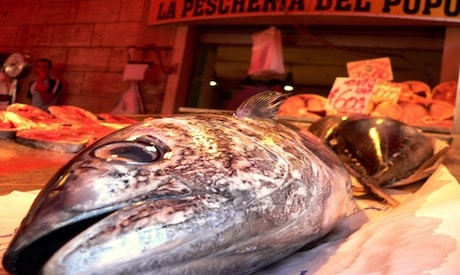
While it may seem like a modern invention, “aquaculture,” has been
around for ages – man has been “farming” fish in net enclosures, ponds,
vats, urns and even woven baskets for thousands of years. More recently
though, say within the last few decades, worldwide demand has exploded
and farming fish has grown just as rapidly, evolving into a
multi-billion dollar industry. Its mission: to produce more fish
quicker, faster, larger and cheaper to meet the insatiable demand for
what once seemed a limitless and inexpensive source of protein and good
fat.
Not surprisingly, the extraordinary growth of the fish farm business
has brought with it a number of industrial farming problems that concern
me enough to advise all my patients to avoid factory-farmed fish. While
there are some fish farmers producing eco-friendly and healthy fish,
they are the exception, not the rule, so unless you’re able to purchase
fish from those types of purveyors (usually smaller-scale, artisanal or
boutique-style fish farms), just say No Tanks…that is, no to farmed fish – and here are five simple reasons why:
Read about the trouble with tilapia
1) There’s no such thing as a free-range, farmed fish
In fact, it’s quite the opposite, with fish farm enclosures packing
the creatures in, well, like sardines, leaving little room for the fish
to swim freely or to engage in their normal behavioral patterns. The
result? Stressed fish, who like us, tend to get sick more easily when
their defenses are down. With their immune systems compromised, the fish
become more prone to illness, parasitic infections and diseases, which
then can spread quickly through their over-populated aquatic quarters.
2) Farmed fish are like really into drugs, dude
Next, the sickened fish have to be made well again, with you guessed
it, drugs. To do this, farmed fish are fed antibiotics, antifungals
and/or pesticides – which means so are you, with every fork-full. Hardly
an appetizing thought. As if that weren’t enough, farmed fish are often
injected with booster shots of sex hormones. Turns out, captive fish
populations tend to produce fewer offspring, so fish farms often enhance
Mother Nature with fertility treatments (i.e., hormone shots, special
feed, etc.) to stimulate offspring production and pump up the yield.
With this in mind the question becomes, what are those fish hormones
doing to our bodies? And is it worth the risk? I don’t think so.
3) Their diet is simply revolting
As is the case with industrially farmed, land-based livestock, top
quality, 5-star feed isn’t on the menu, so what does the average farmed
fish eat? Mostly fishmeal. Sound innocuous enough, that is till you
discover that fishmeal is made up mostly of smaller fish mixed with
(presumably genetically-modified) soybeans, grains and corn. Possible GMO issues aside, the larger issue is that in order to make all that
fishmeal, a tremendous amount of smaller fish are fished out of the sea –
anywhere from 3-to-6 pounds of small fish are needed to produce just
one pound of farmed fish. In addition to being an enormously wasteful
process, it also leaves less food available for wild fish to feed on,
which contributes to their population declines. Oh, and what else do
farmed fish snack on? The carcasses of deceased neighbors floating in or
lying at the bottom of their tanks. It’s not a pretty picture.
4) If you’re looking for nutrition, farmed fish falls short
Even if you could overlook the drugs, hormone shots and
less-than-optimal diet, farmed fish still comes up short in terms of
nutrition, one of the reasons so many of us turned to fish in the first
place. Compared to wild fish, farmed versions can have as much as 20%
less protein, twice as much inflammation-boosting omega 6 fatty acid,
less usable omega 3’s and fewer nutrients overall. In short, wild is
better.
5) Industrial fish farms pollute their surroundings
Numerous studies report that water quality suffers in areas where
fish farms operate, creating something akin to the aquatic version of
agricultural run-off. Decaying fishmeal, diseased and dying fish and
their waste products combine to create conditions that enable bacteria
to flourish, polluting not only the fish farm waters but seeping into
and damaging neighboring wild fish habitats, marshes and wetlands either
by accident, carelessness or poor fish farming methods. Isn’t all this
damage and pollution is too high an ecological price to pay for farmed
fish-on-demand? I believe it is.
So, with all this in mind, what’s the alternative to farmed fish? The
answer is wild fish though the wild stuff is not without its own set of
issues, including over-fishing, dwindling populations and mercury
concerns. To help you make the best possible choices, when buying fish
at the market or dining out, ask questions and find out where your fish
is sourced, and if it’s fished sustainably. Before you buy, check your
choices with the Blue Ocean Institute’s helpful Guide to Ocean Friendly Seafood or download printable lists of eco-friendly seafood recommendations from Seafoodwatch.org
Read more about our sushi investigation
For more on how to make informed seafood choices, check out School Yourself the Smart Way to Eat Fish.
Editor's Note: This article originally appeared on DrFrankLipman.com.
Image: ezu




